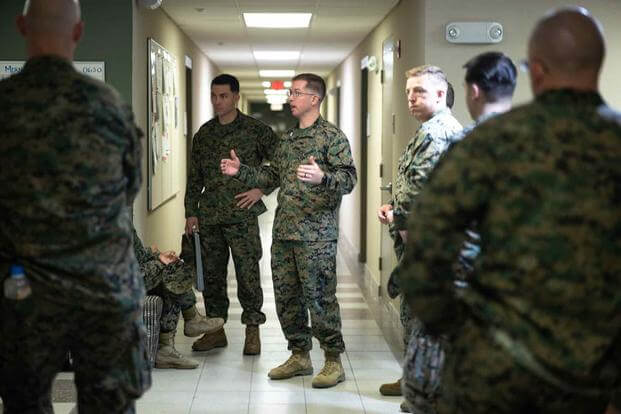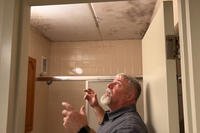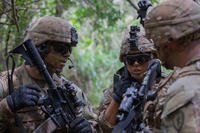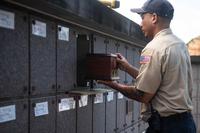Nearly half of the Marine Corps' barracks -- about 49% -- were found to have problems following a force-wide inspection earlier this year, but only a tiny fraction of those issues such as mold stemming from poor ventilation, temperature and moisture control resulted in Marines being moved, service officials said Wednesday.
Less than 1% were considered "non-mission capable," requiring 118 Marines to be moved from a total of 97 rooms. The rest of the barracks -- the other half -- had "no issues, no discrepancies," said Maj. Gen. David Maxwell, head of Marine Corps Installations Command, or MCICOM.
The inspection took place between February and March, a quick time frame for a herculean task that involved looking at hundreds of barracks buildings and roughly 60,000 rooms around the world. It was meant to better understand the state of the barracks, which have come under scrutiny in recent years for having dismal conditions across the military, and to make sure that leaders addressed immediate health and safety concerns for Marines who live in them.
Read Next: How to Think, Not What to Think: The Corps Is Trying to Change the Way Marines Learn and Teach
Ventilation, to include heating and cooling systems; water issues; and mold were primary factors that led to more than 100 Marines being relocated from their barracks rooms. Other issues were found in nearly half of the barracks, too, but were not severe enough to warrant relocation, officials said.
"It's not just the condition of the barracks," Maxwell said in a panel Tuesday at the Modern Day Marine Expo in Washington, D.C. "It's about the leadership that's happening on the ground, the small-unit leader level that is affecting that Marines readiness -- it's them taking looks at the barracks and making sure that the guarantees that the Marine Corps has said we owe to our Marines, that we're fulfilling them."
A spokesperson for MCICOM, Maj. John Parry, said that the service was still assessing the feedback as of Wednesday, but noted the urgency with which the Corps wanted to take account of the barracks issue. He also said that, of the 97 rooms that were deemed unlivable, 68 have been brought up to Marine Corps standards.
Maxwell said that two of the top problems inspectors discovered were ventilation and water issues. When combined, they led to "the beginning and varying degrees of growth," he told reporters after the panel. In a MCICOM memo, the Corps referred to mold as "unidentified biological growth" until tested by a hygiene specialist.
Other issues the inspectors looked at were lock functionality, doors being able to close and rooms being free of gas hazards, as well as water damage or "strong musty odors," according to a checklist used in the inspection provided to Military.com by MCICOM.
Maxwell was hesitant to describe the assessment on a "pass or fail" basis, describing rooms that were deemed to have issues, but minor ones, as still livable. He characterized the results of the inspection as being "mission capable" or "partially-mission capable," the latter meaning that there were issues, "but not to the extent that it required moving Marine[s] out of the barracks room," he said.
"What we found is that, out of those barracks that we inspected, by and large the vast majority of them" fell into those two categories, he said.
According to criteria provided to Military.com by MCICOM earlier this year, Marines were to be placed in temporary housing if certain issues -- such as no running water, broken door locks or unsecured window repairs -- would take longer than two days to fix.
If "unidentified biological growth" was discovered, service members were to be moved if it could not be assessed by professionals within 72 hours.
As the planning for the wall-to-wall inspection began, the Corps looked for a suitable checklist to assess the barracks. Maxwell said they used and modified a preexisting checklist focusing on health and safety, which included those pass or fail categories, as well as two others: "pass with condition" and "pass with non-environment, health and safety" concerns. When asked, officials did not immediately have the breakdown of how barracks fared in each of those categories.
"It's a yes or no question, that's been interpreted as a pass or fail," he said. "And I think one of the things that we learned as we walked through was that, 'Wait a minute, a leaky faucet?' Yes, it's a no, but it's not necessarily ... a fail."
The broad force-wide inspection's results were revealed following a panel at the Modern Day Marine expo with Marine leaders who have roles that directly impact quality-of-life issues for Marines, including Maxwell; Lt. Gen. James Glynn, deputy commandant for manpower and reserve affairs; Lt. Gen. James Adams, deputy commandant for programs and resources; and Sergeant Major of the Marine Corps Carlos Ruiz.
That panel, which was in front of a packed house, faced some tough questions from the crowd, including from Marines themselves.
One sergeant out of Camp Lejeune, North Carolina, said that she and other Marines she knew had trouble making the barracks into a comfortable living place after moving from building to building so many times, adding that it's gotten to the point where she and others "don't unpack anymore."
"What can we do to really change the attitude of the barracks from it being an extension of the workplace to it being a home?" she asked.
One Marine major asked the panel, "Has anyone actually been held accountable, or going to be held accountable, for failures in the barracks in a formal manner?" He added, after being asked to clarify his question, that he believes the barracks issue to be an "organizational failure," rather than a unit-level one. He cited the wall-to-wall inspection as a symptom of that failure.
"So, I am the organizational failure that happened," Maxwell said, saying that he did not have the data collection tools to effectively assess and communicate up the chain of command the problems with the barracks, outside of anecdotal reports.
He referenced a 2023 Government Accountability Office report, which was covered by Military.com in September, that showed squalid living conditions across the force as a prologue to the wall-to-wall inspection.
"And the only way I was really able to come back and have a conversation with senior leadership about what we actually have was to go in and do the wall-to-wall inspection," he said. "And why is that? Well, because of the systems that we have, the information that we have, quite honestly, just isn't set up to provide that level of visibility at the enterprise level."
Related: The Marine Corps Completed Its Force-Wide Barracks Inspection. Here's How it Went.












